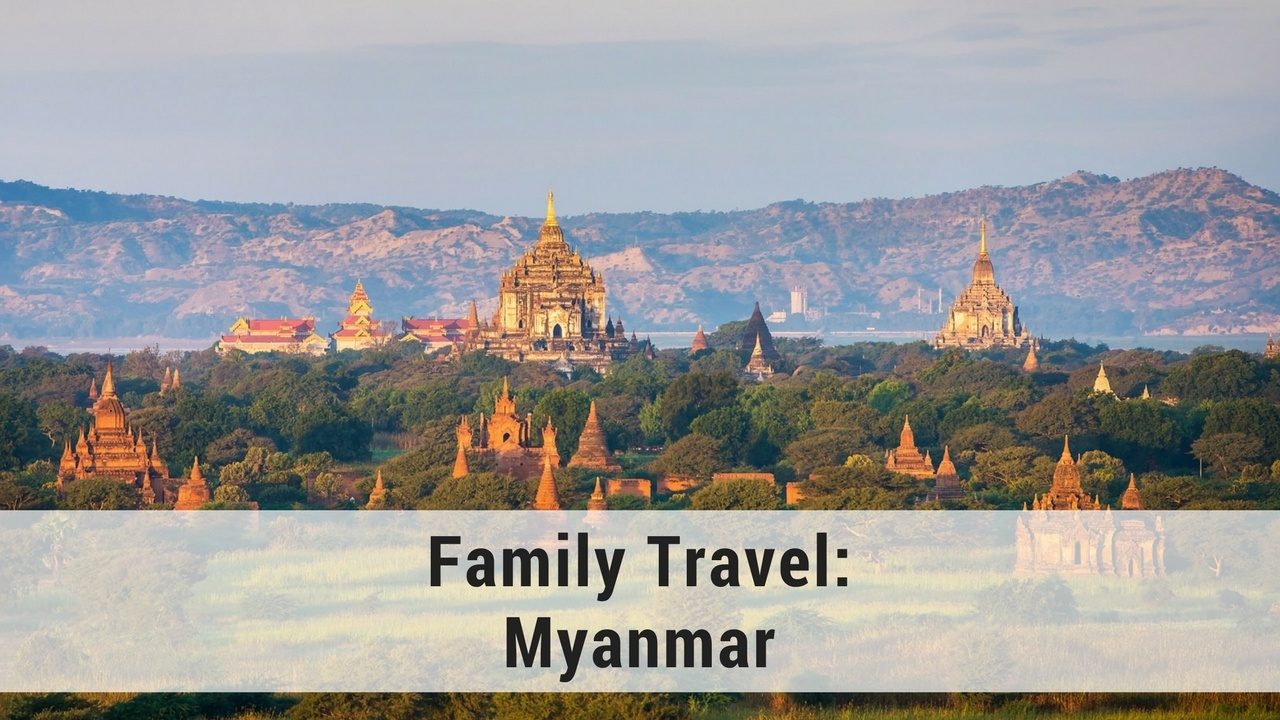Myanmar (previously also known as Burma) had long been on our bucket list. The only question was: would it be doable with young kids in tow, 6 and 5 years old?
Long story short: Once we woke up to a beautiful blue sky in Yangon, we fell in love with this tropical country. I only regret that we didn’t have a second day for Yangon. Though not the capital anymore, it’s still the country’s largest city with a unique mix of temples, lakes, markets and teahouses. Most notably, it boasts amazing architecture from those exciting times when Yangon was a real hot spot in Asia. In 1852 the British took over as new masters, rebuilt the heavily damaged city and even changed its name to “Rangoon”. Hard to believe today, but by the early 20th century the busy trade hub was one of the most modern cities with an infrastructure rivalling that of London!
Yangon I: Shwedagon Pagoda
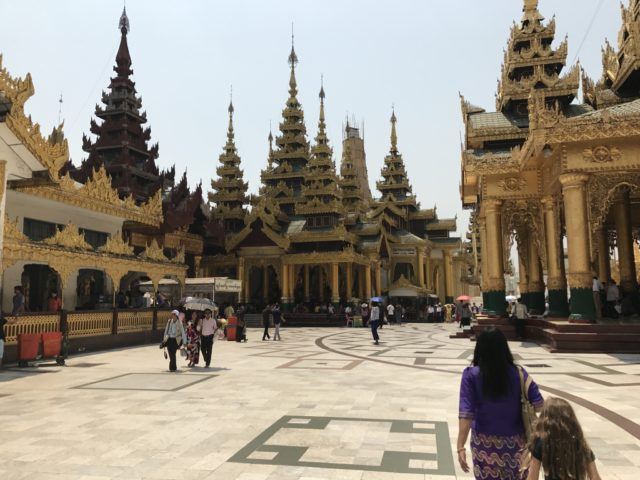
A tour guide greeted us after breakfast and off we went to the famous Shwedagon Pagoda, glittering in plain gold high above the city. For once upon a time there was a great king, Okkalapa, who was presented with some strands of hair of the REAL Buddha – and was told that he should guard it well. The king built a temple of gold on the summit of a sacred hill.
The pagoda has been rebuilt and extended many times for hundreds of years – and is still the holiest of all religious sights. The entrance fee includes a lift ride to the platform of the stupa – which was greatly appreciated at temperatures of 37 degrees and given the overwhelming size of this monument.
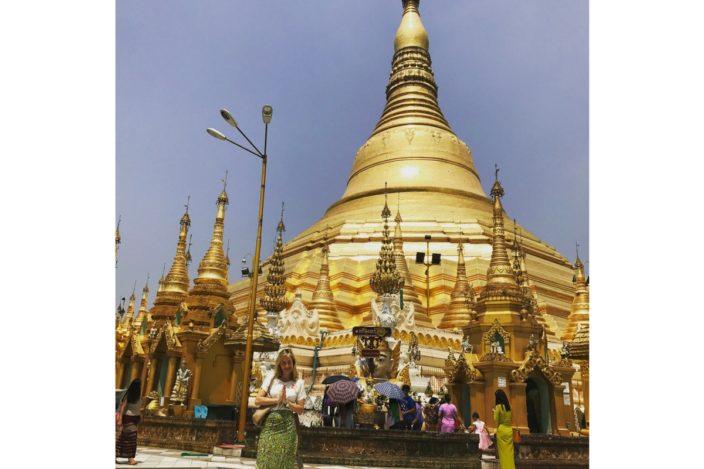
We missed the fortune-tellers at the famous weekday-corners where you are supposed to bring offerings – apparently a very important thing here as we learnt only after our visit. But we enjoyed watching the activities of upbeat pilgrim-families and those cute little future monks. As summer means three months holidays for most of Myanmar’s kids, many parents send them to the nunneries for a few weeks– hoping to get a direct link to Buddha later. And despite their future dignity, most boys engaged in practical jokes and enjoyed their candy donations.
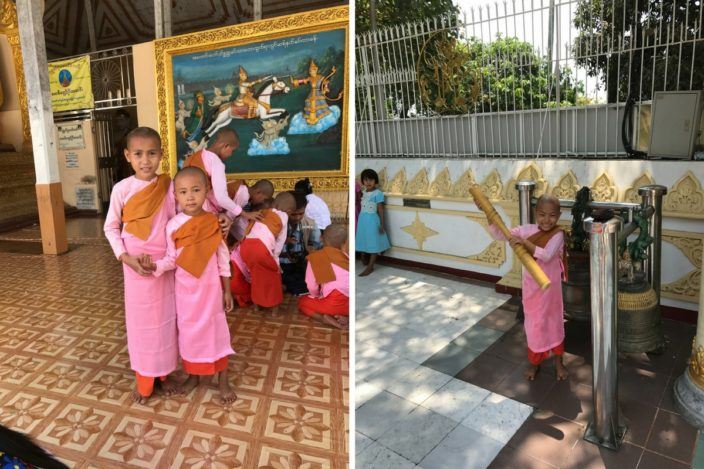
Our kids were more interested in posing as Buddhas themselves or ringing the gongs and bells than exploring every corner of the overheated Pagoda. (There is some debate whether it’s better to visit in the morning or late afternoon. Now we would definitely go for a sunset-tour!) So when the tour guide suggested to visit Bothahtaung, another famous Pagoda – our daughter firmly objected. We opted for the National Museum instead, a four storey building with air condition whose beautiful artefacts didn’t fail to impress. The most famous is the lion throne of the last king of Myanmar – at least 10 metres high.
Yangon II: Stop and Go to Colonial Mansions
For lunch we headed to Yangon Teahouse, a bubbly restaurant led by a young, creative chef on Pansodan Road. The wide road builds an important artery of the colonial quarter, which we planned to explore next by feet. But our tired kids insisted in sightseeing by bus, which made the tour fairly swift – yet it was still interesting.
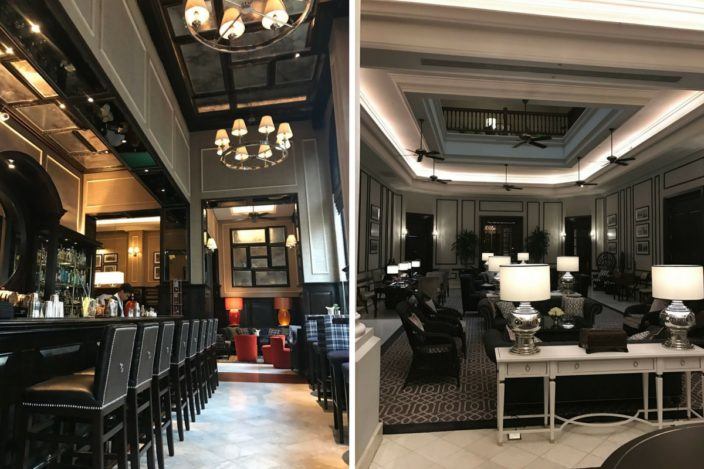
Yangon has the highest number of colonial era houses of all South East Asia. Unfortunately most of these grand old buildings and streets appear not in best shape as the socialists left them to decay over the second half of the 20th century. Trees grow out of roofs, rats cohabit peacefully with local tenants. drying laundry hangs everywhere. And the traffic is gross! Motorbikes and scooters are already forbidden – but people are still constantly on the move by bus or piled up on pick up trucks. Stop, go, another traffic light.
Anyhow, the kids loved watching market scenes from their elevated, air-conditioned seats: How people in Myanmar buy a fish or a chicken and how the butcher acts on the street. Furthermore, we enjoyed our peeks at barbershops, street side restaurants and the ubiquitous teashops. At the same time, we ticked most recommended sights on Yangon visitor’s list – finest European colonial architecture, sometimes even mixed with Indian influences. The General Post Office, the Main Station, St Mary’s Cathedral, Customs House and last but not least the grand and beautifully renovated Strand hotel. If you have time: Please stop at the bar for a drink! We couldn’t since the kids decided ‘it’s pool time now at our hotel!’
Bagan I: Where Ancient Sites Spring up Like Mushrooms
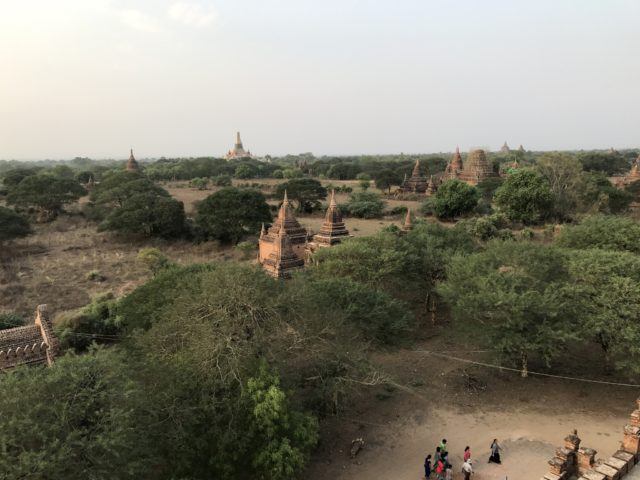
The very next day we had to leave early for our domestic flight to the ancient sites of Bagan or bureaucratically the ‘Bagan Archaelogical Zone’ as visitors are told at the airport before they must hand over a maintenance fee of $15 USD. Fair enough – given the abundance of religious sights one is going to see on the grounds of the first Burmese kingdom. The exact number is unknown, but between 2000 and 3000 holy buildings are scattered across 26 sq-miles (out of 13,000 in the past!)– temples, monasteries and pagodas, many of them in ruins. Our Bagan-guide waited already at the tiny airport. Probably in his mid-forties, he wore a hipster-bun, horn-rimmed glasses and a sarong. “Call me Coco like Chanel”, he said. Questions? This guy was fun.
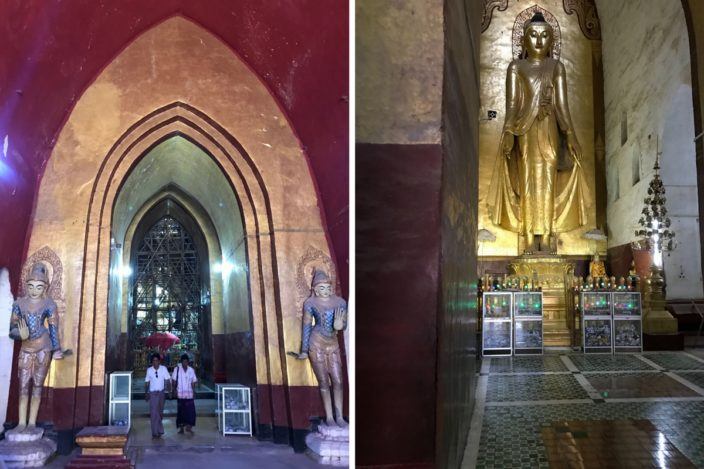
We got a map, but found it still hard to keep track with all the amazing mushroom-shaped sites to our left and right. From 11th till 13th century the “heart of Burma” was the home of the kings – and each of these guys wanted to express his might. The Ananda temple might be the most elegant with its four huge golden Buddhas surrounded by red walls. But I also loved the quiet atmosphere at Htilominlo Temple with its beautiful garden. All in all, we visited probably eight or nine temples and pagodas. When the kids got tired, Coco quickly came up with some diversionary tactics e.g. he showed them sleeping bats under the roof with his torch – so that we could enjoy the splendour of the carefully restored murals in peace. I created a new hash tag #moveoverangkor – and couldn’t get it out of my head anymore.
Bagan II: Horses, Hot Air Balloons and Temple Cats
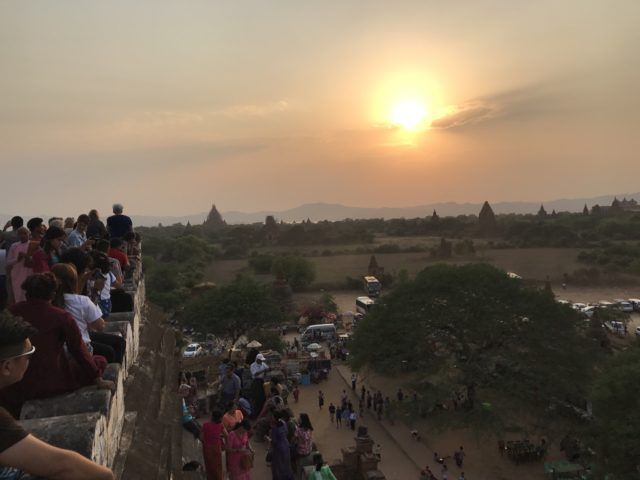
Sunset at the Shwesandaw Pagoda was the highlight of the day – though we were certainly not the only family there. Lots of other tourists and even pilgrims had already found their sunset spots. Coco asked us to walk up a few flights on our own now since he is afraid of heights – and my son promptly started complaining. “Too high, too hot!” he ranted. But Coco had already a plan B: “Do you see the horses and buggy carts here? If you are done with the view, I’ll organise a ride for you. Ok?” Deal! The little one smiled again and started his ascent.
The next morning we were woken by strange sounds that belonged to hot air balloons over Bagan. No doubt, the 45 minute tour at 6.00 a.m. provides visitors with unforgettable views, but the ride doesn’t come cheap (starting price around $300 USD per person) and we didn’t have a booking either – so we had to stay on the ground.
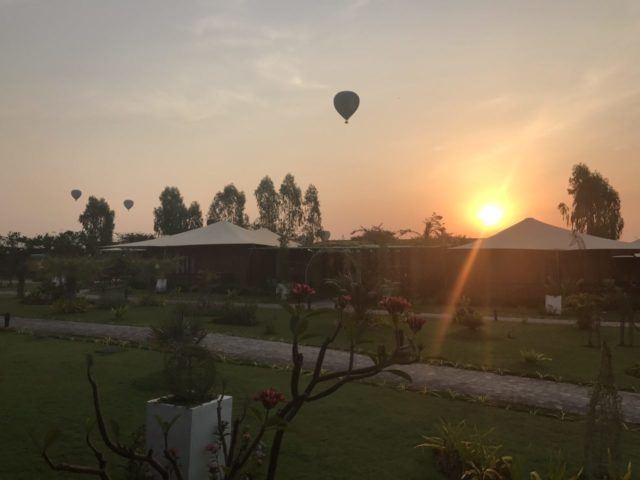
Another popular spot for locals and tourists, the temple Popa Taung Kalat, based on an an extinct vulcano, was skipped by our guide. Not sure if he wanted to spare himself or Jonathan the steep 777 stairs climb. Instead, Coco delegated the driver on a scenic 1,5 hours ride north – where we passed farmers on ox vehicles, bringing their impressive harvest of onions or garlics home. Our goal was the village of Salay. Along some beautiful British colonial buildings there are 50 little monasteries – which are the quite opposite of Mount Popa, tiny and almost forgotten. The 100-year-old Yoke Sone monastery is the most splendid of all, with an amazing Buddha museum, showcasing lots of woodcarvings, Budddha statues and trunks. Next door live around dozen monks, upon our arrival they were lying in old lawn chairs, chanting their holy songs. They don’t speak English, but the universal language of children. And ours were over the moon when they were allowed to play with the temple cats.
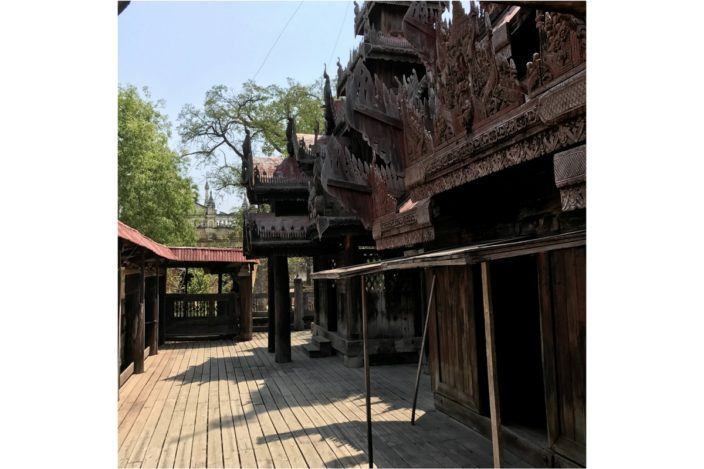
Late afternoon was spent on a so-called “sunset cruise” – a pleasant ride along the majestic Ayeyarwaddy River, where we drunk tea and ate peanuts – while Coco entertained the kids with his magic tricks again.
Inle Lake I: Sightseeing by Boat – Farms, Workshops and Pubs on Stilts
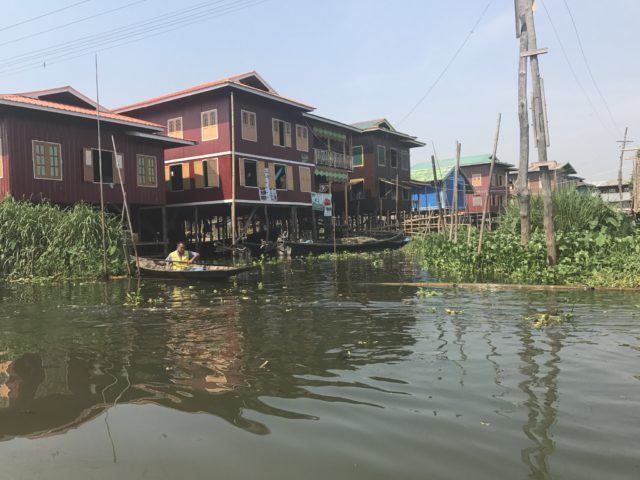
We would have LOVED to stay longer, but we had to move on via another domestic flight the next morning to Heho Airport in the eastern Shan State. A lovely young lady welcomed us, “Mon”. Probably in her late Twenties, she comes from a poor family of mountaineers. As the oldest of four girls, she had to leave her home at the age of 10 – to study at a boarding school for orphans in the city, run by monks. Only once a year she was allowed to come home. “Of course it was hard,” Mon said. “But that’s how life is in Myanmar.”
On the mountain roads heading to our next hotel, Pristine Lotus Spa Hotel we were treated to stunning views. We passed a spectacular rail-bridge on which passengers are traversing when the trains are out of sights. And in Pindaya we stopped at a little workshop where a family produces paper-umbrellas of wet fibres of mulberry trees. Petals of flowers are added on the pulp of paper before drying for hours. What a tedious process! But it’s also an important lesson for kids to see how Burmese people make everything by hand – until today!
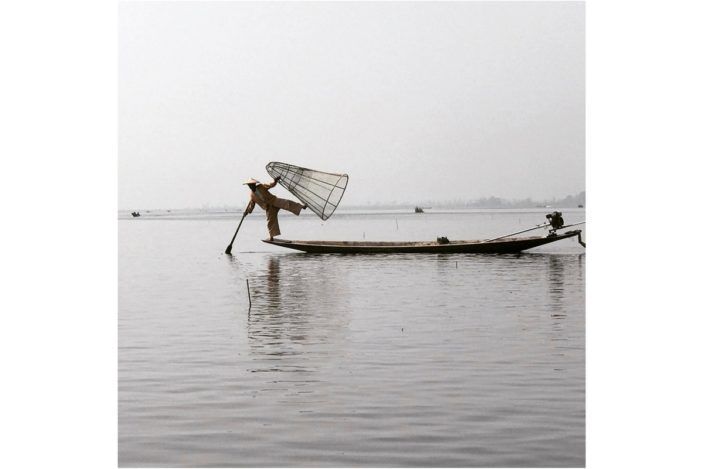
Our final destination was Inle Lake, a 13 mile (21 km) long lake where 70,000 people of eight different ethnic groups make a living mostly from fishing and farming. But we were also to discover more traditional workshops in their wooden stilt houses. Our hotel not only has bungalows shaped like boats, but also its own pier, from where we started every morning in a long boat, well equipped with water and umbrellas against the heat. We met floating marketsellers, saw floating gardens (with crops including aubergines, tomatoes, cucumbers…), even pubs on stilts. My favourite picture of the whole trip was also taken there – of one extremely talented man who moved his barge using the one-legged rowing technique all local fishermen have to learn.
Inle Lake II: A Magical Picnic and More Ancient Sites on the Water
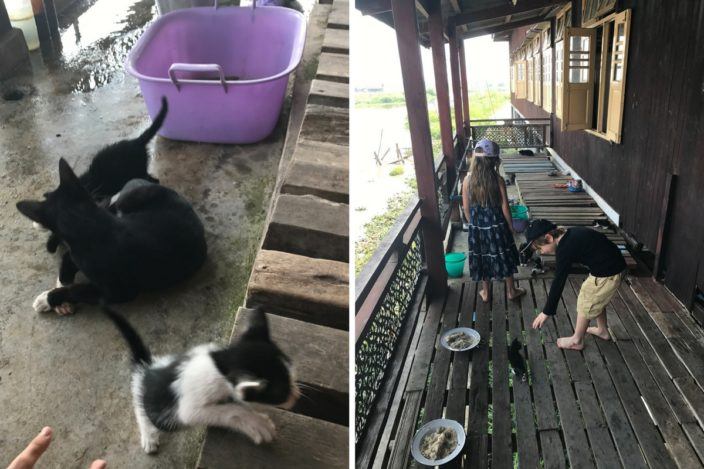
On the second day we visited the monastery in Nga Hpe Kyaung – also known as the “jumping cat monastery”. Although the monks don’t train the cats to artistic demonstrations anymore – plenty of cats still live there. And while we were in awe of the amazing old teak architecture, our kids were more than happy to find young kittens. Afterwards we headed to Heritage Hotel Inle Lake for lunch – a beautiful restored old complex, comprising a boutique hotel, art gallery and sanctuary for Burmese cats. We ate a delicious meal above rice terraces before we visited a silver smith in the neighbourhood, where our son got his best souvenir ever – a real knife for “when he is big”.
The next morning we went to a market next to our hotel, where all the locals gather once a week. During the week it’s pretty hard to get necessities within 20 kilometres distance, so it’s better to stock up here.
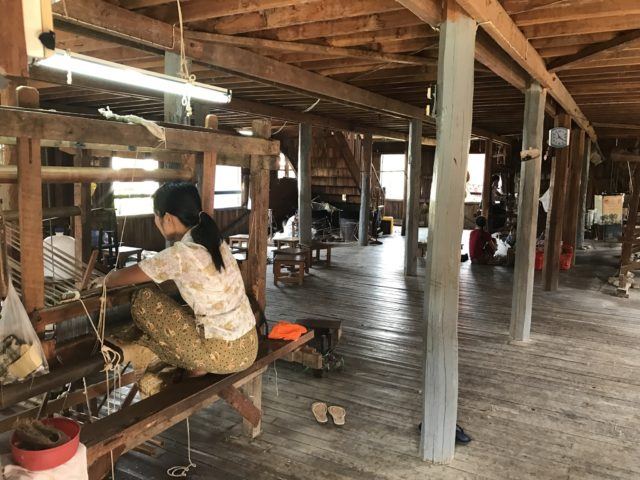
Then the boat was waiting and we went on the lake again. Our first stop was at a lotus workshop, where weavers produce their treasured threads from lotus fibres. We knew that lotus flowers are considered holy, but we didn’t have a clue that you can spin long strands of thread from the natural fibres in its centre. Another beautiful yet extremely lengthy technique! The boat headed farther and half an hour later we stopped near dozens of temples, partly damaged by a recent earthquake: Indein. But before we could visit these sites, Mon had organized a surprise. After 15 minutes walk on a river where mountaineers were washing their weekly laundry, we spotted some blankets, plates and umbrellas set up under bamboo trees. It was definitely the most magical and delicious picnic we’ve ever had.
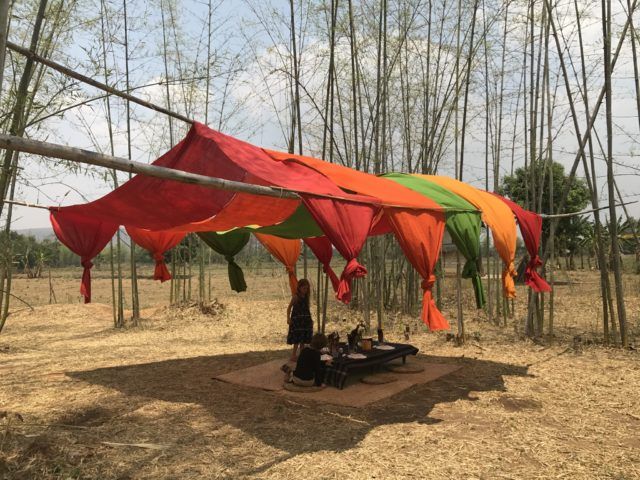
Indein’s temples have yet to be restored, but the atmosphere is surreal and movie-set lovely (think Tomb Raider). We took pictures of a Buddha-head, buried by collapsed stones. Other holy buildings were overgrown with plants – similar to the ones near Angkor/Cambodia. And the great surprise was: We were completely by ourselves.
Unwinding at Ngapali Beach – One of the Most Beautiful Beaches in Asia
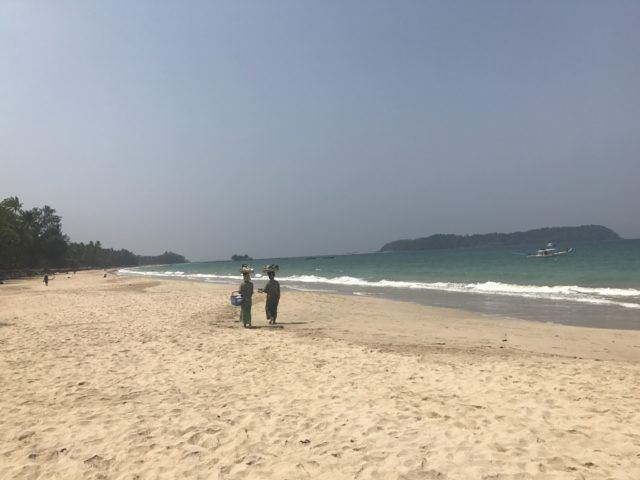
It was then time to say ‘bye bye’ again to the lake and our lovely guide. Instead of moving on to the cultural capital Mandalay, we had opted for three days of tranquillity at the beach of Ngapali (Sandoway Resort) – and this compromise felt just right. Snorkelling and sightseeing trips would also be on offer. But we were absolutely happy with the beach – clean, white and empty – served by some lovely ladies who sold fresh fish kebabs, coconuts and pineapples for less than $1 USD. Their faces were covered by Thanaka, a beige paste made from trees that has been used by Myanmar’s women and children for more than 2000 years. Apparently it has antiseptic and sun-blocking qualities, nevertheless we couldn’t get used to the sights of this unique face paint. 10 days are simply not enough to understand this amazing country.


